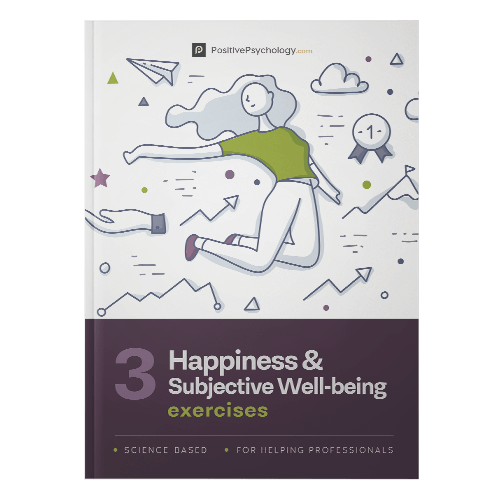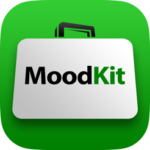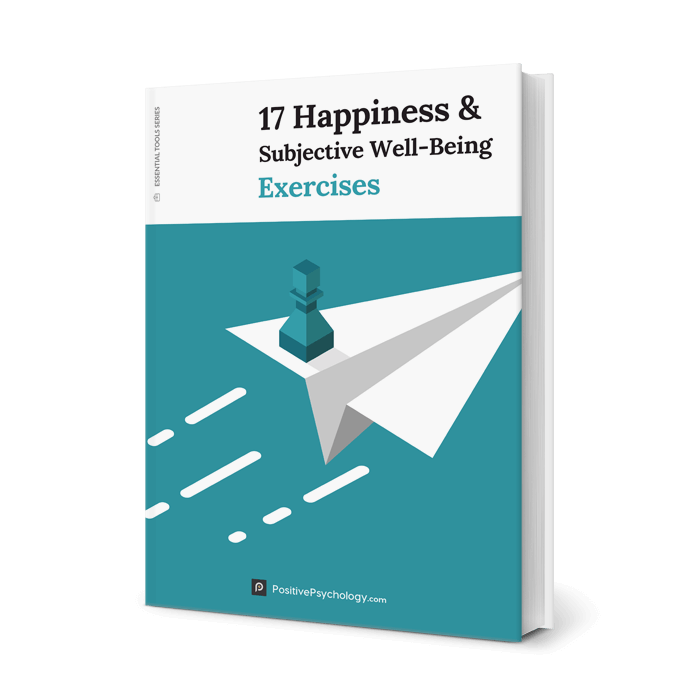6 Happiness Tests & Scales to Measure Happiness

We know when we feel happy and when we don’t, but how can we measure it?
Psychologists have found a way to quantify our happiness using self-report questionnaires. We rate our subjective wellbeing (or happiness) according to a set of statements (Diener et al., 2018).
Unless we can identify where our happiness is at now, it is impossible to target where we want to go: our happiness destination. Improving our happiness is important; happy people are more equipped to handle life’s challenges and adopt healthy lifestyles.
This article introduces several key tests and scales available for scoring happiness, supporting us as we journey toward a more satisfying life.
Before you continue, we thought you might like to download our three Happiness & Subjective Wellbeing Exercises for free. These detailed, science-based exercises will help you or your clients identify sources of authentic happiness and strategies to boost wellbeing.
This Article Contains:
Dr. Seligman’s Happiness Test (aka Authentic Happiness Inventory)
The importance of subjective wellbeing is recognized in the American Declaration of Independence’s mention of the pursuit of happiness, Bhutan’s Gross National Happiness Index, and the United Kingdom’s life satisfaction measures (Grant, 2021; Well-being, n.d.).
Widespread recognition regarding its importance to our wellbeing has led to the predictors of happiness receiving much more research attention.
When Martin Seligman (2011b, p. 11), often referred to as the father of positive psychology, formulated his theory of authentic happiness, he believed happiness could be “analyzed into three different elements that we choose for their own sakes: positive emotion, engagement, and meaning.”
Based on input from other researchers, he later replaced it with his wellbeing theory, adding two elements to arrive at the five pillars of the PERMA model: positive emotions, engagement, positive relationships, meaning, and accomplishment (Seligman, 2011b).
History of the authentichappiness.org test
In Seligman’s (2011a) book Authentic Happiness, he attempts to answer some of psychology’s (and philosophy’s) oldest and most challenging questions: How can we be happy? And how can we live a satisfying life?
As a result, he recognizes the need for measurement.
Seligman (2019, p. 165) describes Chris Peterson in his autobiographical book The Hope Circuit, as being big — six feet and three inches tall — with a “capacious of mind and heart” and a close friend and colleague instrumental to the success of positive psychology.
Peterson worked with Seligman on several tests and inventories. These included the Attributional Style Questionnaire, which scores how we explain good and bad events, and the Values-in-Action Survey, which ranks 24 strengths and compares scores to thousands of others that have taken the test (Seligman, 2019).
Most notably for us, he helped design the Authentic Happiness Inventory. Peterson, Seligman, and colleagues realized that “satisfied individuals report higher satisfaction with life through ‘meaning,’ ‘pleasure,’ and ‘engagement’” (Sigala, 2019. p. 17). Through measuring such factors, it is possible to provide a subjective assessment of happiness.
Their Authentic Happiness Inventory is frequently used to measure changes in happiness — or subjective wellbeing (SWB) — following positive psychology interventions and is considered highly sensitive to subtle changes (Proyer et al., 2017).
In the book Authentic Happiness, Seligman instructs the reader to complete the authentichappiness.org test on the internet, but this address has now been replaced by the University of Pennsylvania’s Authentic Happiness site, with Seligman center stage.
The site remains a vital repository for information on positive psychology, with links to suggested reading, courses, research opportunities, and perhaps most importantly, its measures (Authentic Happiness, n.d.).
The psychology behind measuring happiness
“Researchers have theorized that there are basic and psychological needs that when fulfilled lead to SWB” (Diener et al., 2018, p. 254). Needs such as growth and social interaction have been passed down as part of our evolutionary legacy, becoming universal across individuals, groups, and cultures.
As a result, by measuring such psychological needs, we can score an individual’s happiness and compare it with others (individuals, groups, and populations). Researchers can also measure happiness or SWB at multiple points to identify changes across time.
Knowing that such changes are possible and proven by science gives us all hope.
“People often think, for understandable reasons, true happiness is beyond reach for me because there is so much that I can’t help that is set in stone” (Waldinger & Schulz, 2023, p. 45).
The data tells a different story. For example, it turns out that investing in forming deep and meaningful relationships and focusing on positive emotions, such as gratitude, can boost our happiness in the short term — and across our lives (Waldinger & Schulz, 2023).
Taking the Authentic Happiness Inventory
The Authentic Happiness Inventory is one of several found on the University of Pennsylvania’s website. Once the user registers and creates a login, they select one statement in each of its 24 groups to score happiness, for example (Authentic Happiness, n.d.):
Group 5:
- I rarely get what I want.
- Sometimes I get what I want, and sometimes not.
- Somewhat more often than not, I get what I want.
- I usually get what I want.
- I always get what I want.
Group 9:
- By objective standards, I do poorly.
- By objective standards, I do neither well nor poorly.
- By objective standards, I do rather well.
- By objective standards, I do quite well.
- By objective standards, I do amazingly well.
Group 24:
- My life is a bad one.
- My life is an OK one.
- My life is a good one.
- My life is a very good one.
- My life is a wonderful one.
Meaning of the Authentic Happiness Inventory score
Having completed the assessment by choosing each appropriate statement, the user is told how their scores compare to other individuals and populations.
While not calculating a specific happiness score, the results indicate where their self-reported happiness sits within societal, age, gender, and occupational groups (Authentic Happiness, n.d.).
While Seligman (2011a) suggests that happiness is heritable, with recent happiness genetics research indicating heritability between 30% and 40% (Røysamb et al., 2018), it is also incredibly changeable and driven by how we live our lives and our environment. Knowing our scores can help us make the changes needed to increase our satisfaction with our lives.
5 Top Happiness Scales & Indexes

We’ve already seen the Authentic Happiness Inventory. Here are a few others.
General Happiness Scale
The General Happiness Scale was created by Sonja Lyubomirsky (as cited in Seligman, 2011a). The individual rates each prompt or answers each question by selecting the number on a scale between one and seven that feels most appropriate.
There are four in total, including (Seligman, 2011a):
- Compared to most of my peers, I consider myself …
Select 1–7, where 1 is least happy and 7 is most happy.
- Some people are generally very happy. They enjoy life regardless of what is going on, getting the most out of everything. To what extent does this characterization describe you?
Select 1–7, where 1 is not at all and 7 is a great deal.
All four scores are totaled and then averaged. “The mean for adult Americans is 4.8. Two-thirds of people score between 3.8 and 5.8” (Seligman, 2011a, p. 46).
PANAS Questionnaire
The PANAS Questionnaire involves choosing a word or phrase from a drop-down menu in response to a feeling or emotion.
There are 20 one-word prompts in total, such as:
Excited
Strong
Enthusiastic
Jittery
Irritable
For each one, the user chooses between “very slightly or not at all,” ” a little,” “moderately,” “quite a bit,” and “extremely.”
Some emotions or feelings are treated as having a positive effect (for example, excited, strong, and enthusiastic) while others have a negative effect (such as jittery and irritable). Positive and negative scores are totaled separately.
“High positive-affect people feel great a lot of the time; good things bring them pleasure and joy in abundance” (Seligman, 2011a, p. 34). Those low in positive affect and higher in negative affect do not feel great or good often.
Fordyce Emotions Questionnaire
The Fordyce Emotions Questionnaire is another short test, comprising one question asking the participant to score their general level of happiness and another about the percentage of time they feel happy and unhappy (Seligman, 2011a).
For example:
Rate the following statement using one of 11 scores ranging from “extremely happy (feeling ecstatic, joyous, fantastic!)” and “extremely unhappy (utterly depressed, completely down).”
- In general, how happy or unhappy do you usually feel?
Next, score each of the following between 1% and 100%:
- Percent of the time you feel happy on average
- Percent of the time you feel unhappy on average
- Percent of the time you feel neutral on average
Based on a study including 3,050 adult Americans, the average score for the percentage of time happy is 54.13%, unhappy is 20.44%, and neutral is 25.43% (Seligman, 2011a).
For each test, a percentage is calculated to indicate where the participant scored in relation to those of the same gender, age group, occupation group, education level, and location.
There are other happiness scales and indexes not listed on the University of Pennsylvania’s site. In brief, the following two scales focus on life satisfaction and therefore score our perception of our journey rather than at points (Diener et al., 2018).
Satisfaction With Life Scale
The Satisfaction With Life Scale (SWLS) is a way of scoring individuals’ judgment on their life as a whole using five statements scored between 1 (strongly disagree) and 7 (strongly agree; Diener et al., 1985).
In most ways, my life is close to my ideal.
The conditions of my life are excellent.
I am satisfied with my life.
So far, I have gotten the important things I want in life.
If I could live my life over, I would change almost nothing.
The scores measure subjective wellbeing, split between emotional and cognitive components.
Students’ Life Satisfaction Scale
The Students’ Life Satisfaction Scale is similar to the SWLS but developed for 8- to 18-year-olds (Huebner, 1991).
The participants are given seven statements to rate. They are scored between 1 (strongly disagree) and 6 (strongly agree) except for two that are reverse scored.
Examples include:
My life is going well.
I have a good life.
I would like to change many things in my life.
I wish I had a different kind of life.
For more details on each one and others available, check out our 4 Scales to Measure Satisfaction With Life article.
3 Popular Apps to Measure Happiness
The following apps are valuable downloads for your mobile device and provide practical tools for measuring happiness.
Happify

Based on the results, the app suggests activities to boost your mental wellbeing, such as reducing stress, overcoming negative thoughts, and building greater resilience. Activities include games, writing exercises, and guided meditations.
Find the app in the Google Play Store.
Find the app in the App Store.
Daylio

A calendar allows you to track and compare feelings over time.
Find the app in the Google Play Store.
Find the app in the App Store.
MoodKit
MoodKit combines practical mood-enhancing activities and the ability to capture journal entries, and tracks moods and emotions such as happiness across time.
MoodKit borrows strategies from Cognitive-Behavioral Therapy to offer enhanced personal treatment and manage negative feelings related to specific situations.
Find the app in the App Store.
Bonus: 6 Ways to Find Your Happy Place
It’s not possible to be happy all the time. No one is. And yet, we can increase the happiness in our lives by focusing on what is important to us.
1. Build and maintain good relationships
“Good relationships keep us happier, healthier, and help us live longer.”
Waldinger and Schulz, 2023, p. 278
Happiness studies, including the multigenerational Harvard Study of Adult Development, consistently find relationships to be a crucial predictor of happiness. Make time for family, friends, and peers with whom you have close relationships (Waldinger & Schulz, 2023).
2. Know and use your strengths
Becoming aware of your strengths and finding opportunities to use them, especially in the workplace, is energizing, and research suggests it will improve your performance, enjoyment, and happiness (King, 2016).
3. Recognize and savor positive emotions
We often dwell on what has gone wrong in our lives rather than what is working well. Reflect on all you are grateful for, forgive those against whom you have been holding a grudge, and seek out activities you enjoy.
Positive emotions encourage other good feelings, such as joy, hope, and curiosity, and boost your capacity for satisfaction in life (Fredrickson, 2010).
4. Finding meaningful activities
Believing that what we are doing matters is a crucial ingredient for happiness. Identify how your job makes a positive difference in other people’s lives or find opportunities to engage your passions and interests. Why not offer to help at a community project or nonprofit (King, 2016)?
5. Engage your self-compassion
Compassion can flow in all directions simultaneously. We can experience compassion for others, others can be compassionate toward us, and we can direct compassion inward.
Being kinder to ourselves and those around us can help us form deeper connections and ultimately boost short- and long-term happiness (King, 2016).
6. Know ourselves better
Earlier in the article, we identified several tools for measuring immediate happiness and longer-term life satisfaction. Use them to identify people, activities, and environments that make you most happy.
Schedule enjoyable pastimes and habits into your day and take lessons learned to other areas of your life (Seligman, 2011a).
Best Resources From PositivePsychology.com
We have many resources available for therapists supporting individuals who wish to experience more happiness.
Our free resources include the following:
- Harmful to Helpful Toxic Positivity Phrases
Phrases such as “It’s all good” and “Look on the bright side” are at best unhelpful and, at worst, toxic. This simple exercise offers replacements, such as “I know that this is really hard” and follow-ups, like “I’m here if you’d like to talk.” - Expressing Gratitude to Others
These seven steps can deepen relationship bonds by encouraging us to show appreciation for those special people in our lives.
More extensive versions of the following tools are available with a subscription to the Positive Psychology Toolkit©, but they are described briefly below:
- The Wheel of Life
We often focus too much attention in the wrong places, ignoring what is meaningful and aligned with our values. The following steps help us build a Wheel of Life to rate various domains and increase satisfaction in the most important ones:- Step one – Review the Wheel of Life, taking note of each area (for example, health and fitness, career and work, and family and friends).
- Step two – Rate your degree of satisfaction for each area.
- Step three – Connect the initial scores to create an inner wheel.
- Step four – Reflect on and discuss which areas warrant more attention.
- Step five – Consider what it would take to raise the satisfaction score in these areas.
- Quality of Life Scale
Wellbeing can be thought of as our net satisfaction with our major life domains.
In this exercise, we score our material and physical wellbeing; relationships with other people; social, community, and civic activities; personal development; fulfillment; and recreation.
-
- Step one – Review the items and score each one. For example, how important (between 1 and 7) is “having and rearing children,” “being physically fit,” and “having close friends”?
- Step two – Review the scores to assess your overall quality of life based on multiple life domains.
- Step three – If there are surprises or your quality of life is not where you would like it to be, consider what steps you could take to change things.
If you’re looking for more science-based ways to help others develop strategies to boost their wellbeing, this collection contains 17 validated happiness and wellbeing exercises. Use them to help others pursue authentic happiness and work toward a life filled with purpose and meaning.
A Take-Home Message
Happiness comes from having a good life, though not necessarily an easy one. Scoring our subjective wellbeing helps because it allows us to understand our current degree of satisfaction and identify what we can improve to live a more fulfilling and meaningful life (Waldinger & Schulz, 2023).
Psychologists have developed several self-report questionnaires that quantify happiness using scores attached to statements.
The Authentic Happiness Inventory, developed by Martin Seligman (2011a), measures subjective wellbeing based on whether we are meeting our basic psychological needs. Other measures, such as the General Happiness Scale and the Fordyce Emotions Questionnaire, are short and effective at scoring individuals’ existing happiness levels.
Scales such as the Satisfaction With Life Scale offer us a picture of that person’s life so far, providing insights into whether they are on the right path or should change direction.
Measuring happiness matters because researchers can use the results to compare an individual’s happiness with other lives or, over time, their own.
As mental health professionals, we should find ways to help our clients form deep and meaningful relationships, experience more positive emotions, create higher engagement in their careers, and live fulfilling lives. Ultimately, we can help them live more happily according to their values.
We hope you enjoyed reading this article. Don’t forget to download our three Happiness Exercises for free.
Ed: Updated March 2023
- Authentic happiness. (n.d.). University of Pennsylvania. Retrieved February 27, 2023, from https://www.authentichappiness.sas.upenn.edu/.
- Diener, E., Oishi, S., & Tay, L. (2018). Advances in subjective well-being research. Nature Human Behaviour, 2(4), 253–260.
- Diener, E., Emmons, R. A., Larsen, R. J., & Griffin, S. (1985). The Satisfaction With Life Scale. Journal of Personality Assessment, 49(1), 71–75.
- Fredrickson, B. (2010). Positivity: Groundbreaking research reveals how to release your inner optimist and thrive. Oneworld.
- Grant, A. M. (2021). Think again. Viking.
- Huebner, E. S. (1991). Initial development of the Students’ Life Satisfaction Scale. School Psychology International, 12(3), 231–240.
- King, V. (2016). 10 keys to happier living: A practical handbook for happiness. Headline.
- Proyer, R. T., Gander, F., Wellenzohn, S., & Ruch, W. (2017). The Authentic Happiness Inventory revisited: Addressing its psychometric properties, validity, and role in intervention studies. Journal of Well-Being Assessment, 1(1-3), 77–96.
- Røysamb, E., Nes, R. B., Czajkowski, N. O., & Vassend, O. (2018). Genetics, personality and well-being. A twin study of traits, facets and life satisfaction. Scientific Reports, 8(1).
- Seligman, M. E. (2011a). Authentic happiness: Using the new positive psychology to realize your potential for lasting fulfillment. Nicholas Brealey.
- Seligman, M. (2011b). Flourish: A new understanding of happiness and well-being and how to achieve them. Nicholas Brealey.
- Seligman, M. E. (2019). The hope circuit: A psychologist’s journey from helplessness to optimism. Nicholas Brealey.
- Sigala, A. M. (2019). Thankful marriages: Mindfulness and gratitude as predictors of marital satisfaction in Greek couples. (Master’s thesis, Harvard Extension School). Retrieved February 19, 2023, from https://dash.harvard.edu/handle/1/37365080.
- Waldinger, R. J., & Schulz, M. S. (2023). The good life: Lessons from the world’s longest scientific study of happiness. Simon & Schuster.
- Well-being. (n.d.). Office for National Statistics. Retrieved February 27, 2023, from https://www.ons.gov.uk/peoplepopulationandcommunity/wellbeing.
Let us know your thoughts
Read other articles by their category
- Body & Brain (49)
- Coaching & Application (57)
- Compassion (26)
- Counseling (51)
- Emotional Intelligence (24)
- Gratitude (18)
- Grief & Bereavement (21)
- Happiness & SWB (40)
- Meaning & Values (26)
- Meditation (20)
- Mindfulness (45)
- Motivation & Goals (45)
- Optimism & Mindset (34)
- Positive CBT (28)
- Positive Communication (20)
- Positive Education (47)
- Positive Emotions (32)
- Positive Leadership (18)
- Positive Parenting (4)
- Positive Psychology (33)
- Positive Workplace (37)
- Productivity (16)
- Relationships (46)
- Resilience & Coping (36)
- Self Awareness (21)
- Self Esteem (37)
- Strengths & Virtues (31)
- Stress & Burnout Prevention (34)
- Theory & Books (46)
- Therapy Exercises (37)
- Types of Therapy (64)






What our readers think
Greetings from India.
I am pleased to read this article. Certainly, the happiness levels have been increased to know there are so many tools to assess oneself. However, i did not find any happiness tool designed specifically for Indian population, would love to know if there is one. Thank you for sharing.
Hi Dr. Tanya,
Thank you for your question! I did some digging, and I found this article which explores the validation of happiness assessments in various Indian social classes – perhaps it will be of interest to you?
I hope this helps!
Kind regards,
-Caroline | Community Manager
Hi Nicole,
Another great app for measuring happiness is Tadysh. It is a free online tool to get a benchmark of happiness and then tips to improve happiness over the coming month.
Hello Nicole,
I liked the article! It is very clarifying. Currently i am doing research into what marketing tactics most effectively work on current happiness levels. Happiness as mood in particular. If i have read the article correctly, the preposed tests only focus on life satisfaction rather than the hedonic levels of affect. Do you know what test can be used to test the latter? Greetings from Holland
Hi Martijn,
Glad you liked the article! Yes, that’s right. If you’re mostly interested in hedonic affect, I’d suggest looking into the positive dimensions of the PANAS, which assesses activation and hedonic tone (you can read more about this scale here).
Hope this helps!
– Nicole | Community Manager
A huge thanks for giving a nice overview on the topic of how to meassure happiness!
Currently I am leaning towards the authentic happines inventory but it seems no so easy to access, I want to find out the happiness before and after laughter and positive psychologic intervention in patients with COPD (chronic obstructive pulmonary disease).
Which questionnaire would you recommend to assess the happiness before and after?
Thanks for you imput
Hi Philipp,
Glad you found the post helpful. What you’re describing sounds as though it uses a pre-test post-test style design. I’ve done a quick search for happiness scales used with this type of design and it appears as though the Oxford Happiness Questionnaire is commonly paired with intervention studies in this way (you’ll see what I mean if you do a search in Google Scholar for ‘happiness inventory pre-test post-test’). So, I’d suggest taking a look at this one first (and past research using it) to see if it will do the job.
I hope this helps!
– Nicole | Community Manager
Dear Nicole
Thanks for the article. I am really fascinated by the many different surveys available for measuring one’s level of wellbeing. I would like to conduct research that investigates how the level of wellbeing correlates with health or disease states and whether increasing one’s level of wellbeing can be associated with healing. Which survey would you suggest would provide the most objective assessment of the level of wellbeing?
Kind regards
Roshan Ebrahim (PhD)
Hi Roshan,
I’m glad you enjoyed the article. To answer your question, you’ll bump up against lots of schools of thought when you’re trying to pick a subjective well-being measure. But one that is widely used is Ed Diener’s Satisfaction With Life Scale. In general, I’d recommend taking a look at Diener’s Google scholar page and reading someone his highly cited papers on well-being so that you can get a grasp of the literature and thinking before settling on a measure.
Hope this helps!
– Nicole | Community Manager
Hello Nicole,
Nice article.
want to know that any authorized test available for measuring happiness index?
Hi Prof. Virat Goude,
For a widely used index of subjective happiness, check out Lyubomirsky & Lepper (1999) here.
Hope this helps!
– Nicole | Community Manager
Very useful article. I found it simple with a multi-angle view on happiness. Thank you.
Article is helping me to understand happiness in a better way. It was good learning experience. Any project for me in India let me know.
Hi Sandeep,
Glad to hear you enjoyed the article. Thanks for reading.
– Nicole | Community Manager